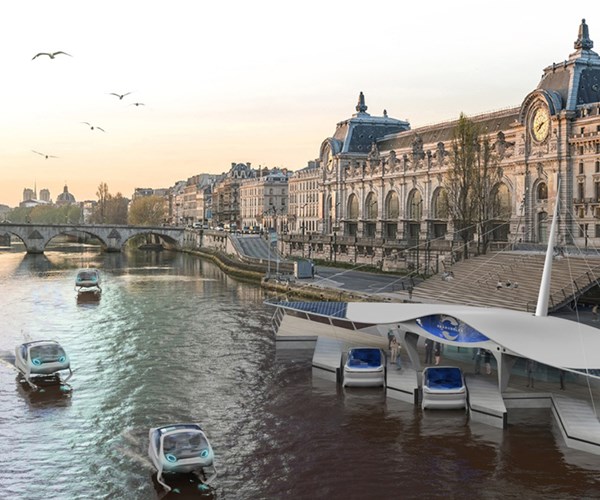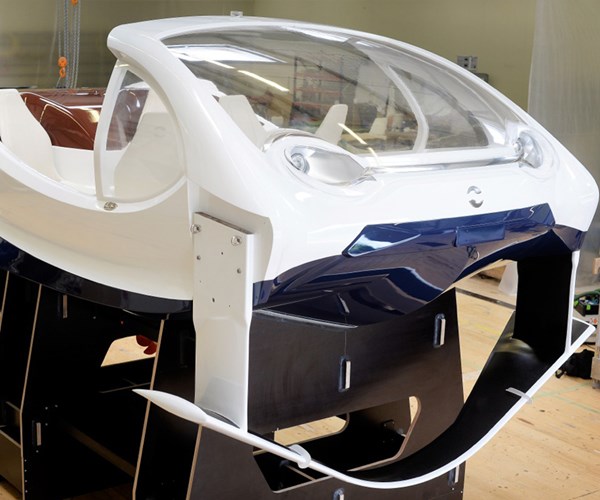Coming soon to the urban waterways: SeaBubbles
All-composite hydrofoiling watercraft will, if SeaBubbles has its way, soon be taxiing people across urban waterways in more than 50 cities across the world.

SeaBubbles concept, Paris, France.
SeaBubbles (Paris, France) is a company and a project. The project is the brainchild of hydrofoiling yachtsman Alain Thébault and champion windsurfer Anders Bringdal. Their vision of creating an eco-conscious taxi transport solution for the world’s urban waterways has come to fruition with the support of composites Décision SA (Ecublens, Switzerland) and Sicomin Epoxy Systems (Chateauneuf les Martigues, France) a formulator and supplier of high-performance epoxy systems.
SeaBubbles are based on a hydrofoil design that allows the watercraft to glide silently above the water when it exceeds 12 kph/7.5 mph. A clean charging electric drive system converts solar, wind and water power so the vessel does not generate any CO2 emissions.
Décision SA, part of the Carboman group, working with SeaBubbles and Sicomin, has so far completed the first of five SeaBubbles water taxi prototypes and these were launched in June 2017 on the River Seine in Paris. The boats were delivered in record time with material specification, design analysis and production achieved in less than four months. Décision is now on track to produce the remaining four prototypes that will also be in service in Paris starting in September 2017.
Décision faced a particularly daunting challenge with this project in that it was particularly important to focus on future production and not just the initial prototypes. To match the ambitious growth plans of the SeaBubbles team, it was vital to consider a robust, sustainable and cost-effective serial production route from the outset.

SeaBubbles prototype.
Working alongside the SeaBubbles team, Décision analyzed the initial design and delivered production-ready tooling and a production-ready composites manufacturing process.
In addition to satisfying the composite engineering targets for weight and stiffness, Décision’s manufacturing process was also required to include a significant percentage of bio-based materials. For material development, Sicomin was chosen because of its history as a formulator and supplier of a range of bio-based epoxy resins, natural fibers and core materials.
All of the SeaBubbles composite parts are produced using a vacuum infusion process where the sandwich structure comprising of reinforcement fibers and a natural cork core are infused with Sicomin’s GreenPoxy InfuGreen810 advanced resin system.
InfuGreen 810 contains 30% carbon content that is derived from plant-based origins. It also has extremely low viscosity at room temperature. Sicomin has formulated the advanced bio product to support manufacturers producing parts for mass production using injection or infusion techniques and the system is available with a variety of hardeners, making it suitable for small to very large components. InfuGreen 810 also holds DNV GL certification providing extra assurance of the products quality, efficiency and safety standards.
Sicomin also supplied a range of complementary materials to provide a package of infusion-specific products including glass fiber multiaxial fabrics, PVC foams with bespoke perforation patterns for infusion, release agents and epoxy spray adhesives to securely position dry fabrics in the molds.
“SeaBubbles has unified a group of companies with eco-friendly ambitions to create a truly innovative concept in transportation. Décision has been the perfect development customer with their experience of creating exceptional quality and performance parts whilst using a wide range of bio-based epoxy resins, natural fibres and core materials. The SeaBubbles team provided us all with a vision to follow,” comments Philippe Marcovich, president of Sicomin.
SeaBubbles reports it is committed to providing its water taxi service at the cost of regular taxi journey and plans to operate in 50 cities within the next five years. Following on from the success of this first phase of the project, a larger 15-seater vessel is also planned for construction later this year.
Related Content
One-piece, one-shot, 17-meter wing spar for high-rate aircraft manufacture
GKN Aerospace has spent the last five years developing materials strategies and resin transfer molding (RTM) for an aircraft trailing edge wing spar for the Airbus Wing of Tomorrow program.
Read MorePlant tour: Albany Engineered Composites, Rochester, N.H., U.S.
Efficient, high-quality, well-controlled composites manufacturing at volume is the mantra for this 3D weaving specialist.
Read MoreMaterials & Processes: Tooling for composites
Composite parts are formed in molds, also known as tools. Tools can be made from virtually any material. The material type, shape and complexity depend upon the part and length of production run. Here's a short summary of the issues involved in electing and making tools.
Read MoreMaterials & Processes: Fabrication methods
There are numerous methods for fabricating composite components. Selection of a method for a particular part, therefore, will depend on the materials, the part design and end-use or application. Here's a guide to selection.
Read MoreRead Next
Composites end markets: Energy (2024)
Composites are used widely in oil/gas, wind and other renewable energy applications. Despite market challenges, growth potential and innovation for composites continue.
Read MoreCW’s 2024 Top Shops survey offers new approach to benchmarking
Respondents that complete the survey by April 30, 2024, have the chance to be recognized as an honoree.
Read MoreFrom the CW Archives: The tale of the thermoplastic cryotank
In 2006, guest columnist Bob Hartunian related the story of his efforts two decades prior, while at McDonnell Douglas, to develop a thermoplastic composite crytank for hydrogen storage. He learned a lot of lessons.
Read More


























